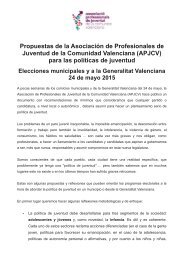c39dc
c39dc
c39dc
You also want an ePaper? Increase the reach of your titles
YUMPU automatically turns print PDFs into web optimized ePapers that Google loves.
Table 2.1 Features of non-formal learning in the youth sector<br />
Common elements in existing definitions<br />
-purposive learning<br />
-diverse contexts<br />
-different and lighter organisation of provision and delivery<br />
-alternative/complementary teaching and learning styles<br />
-less developed recognition of outcomes and quality<br />
Essential Features<br />
-balanced co-existence and interaction between cognitive, affective<br />
and practical dimensions of learning<br />
-linking individual and social learning, partnership-oriented solidarity<br />
and symmetrical teaching/learning relations<br />
-participatory and learner-centred<br />
-holistic and process-oriented<br />
-close to real life concerns, experiential and oriented to learning by<br />
doing, using intercultural exchanges and encounters as learning<br />
devices<br />
-voluntary and (ideally) open-access<br />
-aims above all to convey and practice the values and skills of<br />
democratic life<br />
Non-formal teaching/ training and learning methods<br />
-communication-based methods: interaction, dialogue, mediation<br />
-activity-based methods: experience, practice, experimentation<br />
-socially-focused methods: partnership, teamwork, networking<br />
-self-directed methods: creativity, discovery, responsibility<br />
Source: Council of Europe (2001)<br />
As Fennes and Otten 14 note the term ‘education’ is complemented by<br />
the term ‘learning’ which reflects a shift in terminology that has taken<br />
place in research and policy documents. Fennes and Otten,<br />
moreover, argue that learning is related to activities as well as<br />
individual and group processes while education is more closely<br />
related to systems and outcomes. Thus, a related concept to ‘nonformal<br />
education’ is ‘non-formal learning’. The European<br />
Commission defines ‘non-formal learning’ as “learning that is not<br />
provided by an education and training institution and typically does<br />
not lead to certification. However, it is intentional on the part of the<br />
learner and has structured objectives, times and support” 15 . Informal<br />
learning, on the other hand, is defined as the learning that results<br />
from daily activities related to work, family life or leisure, that is not<br />
structured and usually does not lead to certification 16 . In most cases,<br />
it is unintentional on the part of the learner.<br />
14 Fennes, H. and Otten, H. (2008) Quality in non-formal education and training of European Youth Work. Council of<br />
Europe, Paris.<br />
15 http://ec.europa.eu/education/lifelong-learning-policy/informal_en.htm<br />
16 http://ec.europa.eu/education/lifelong-learning-policy/informal_en.htm<br />
15




